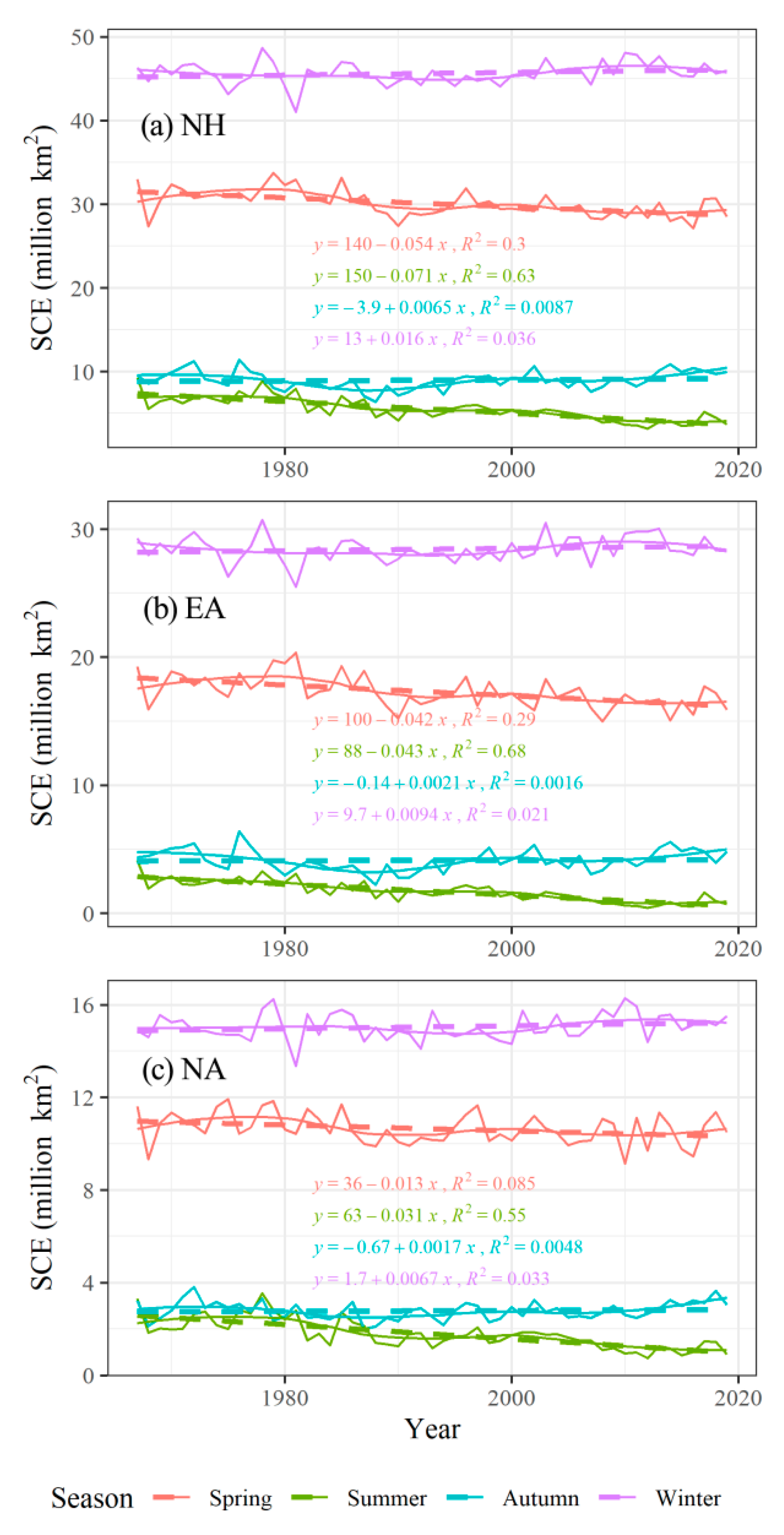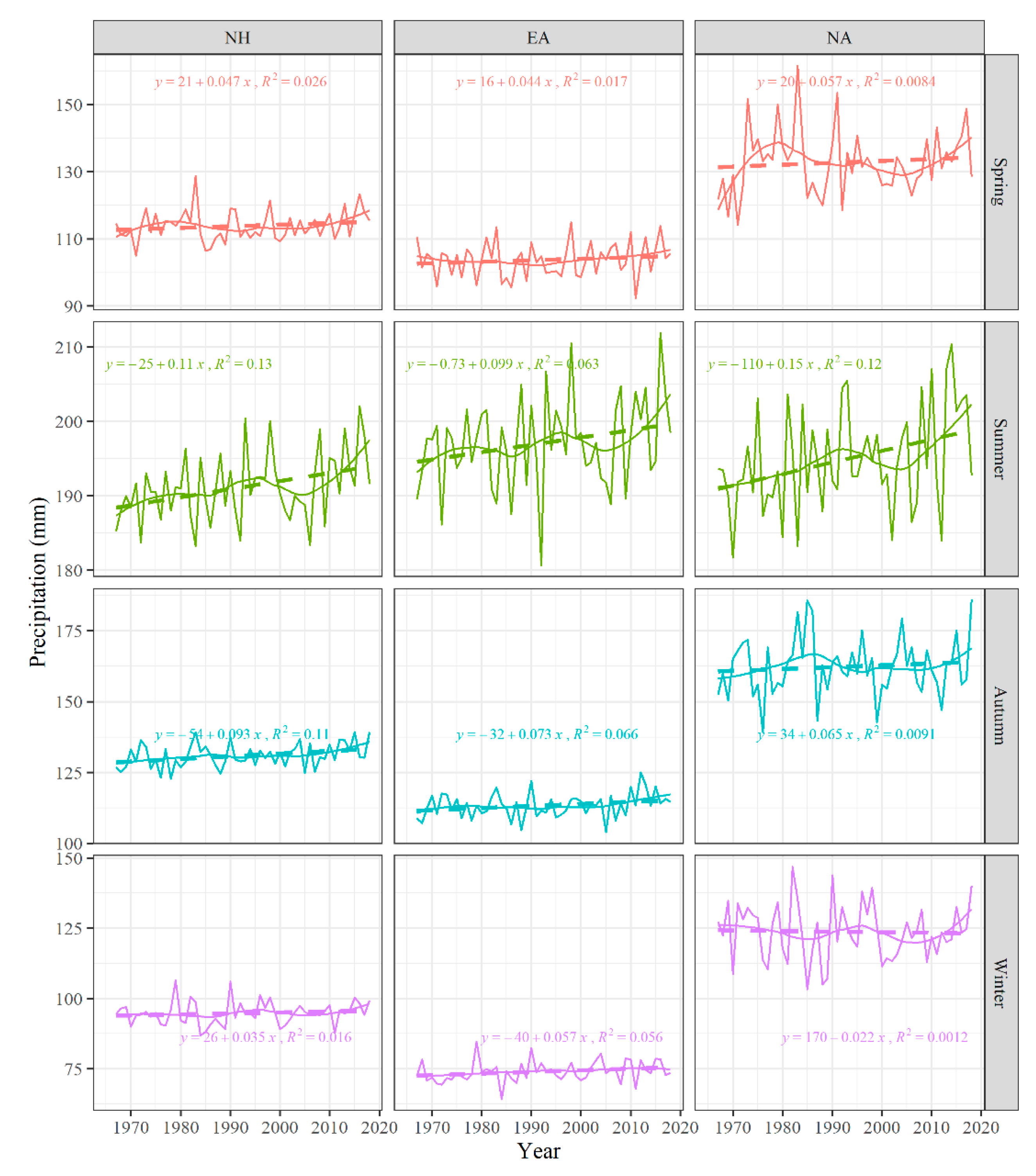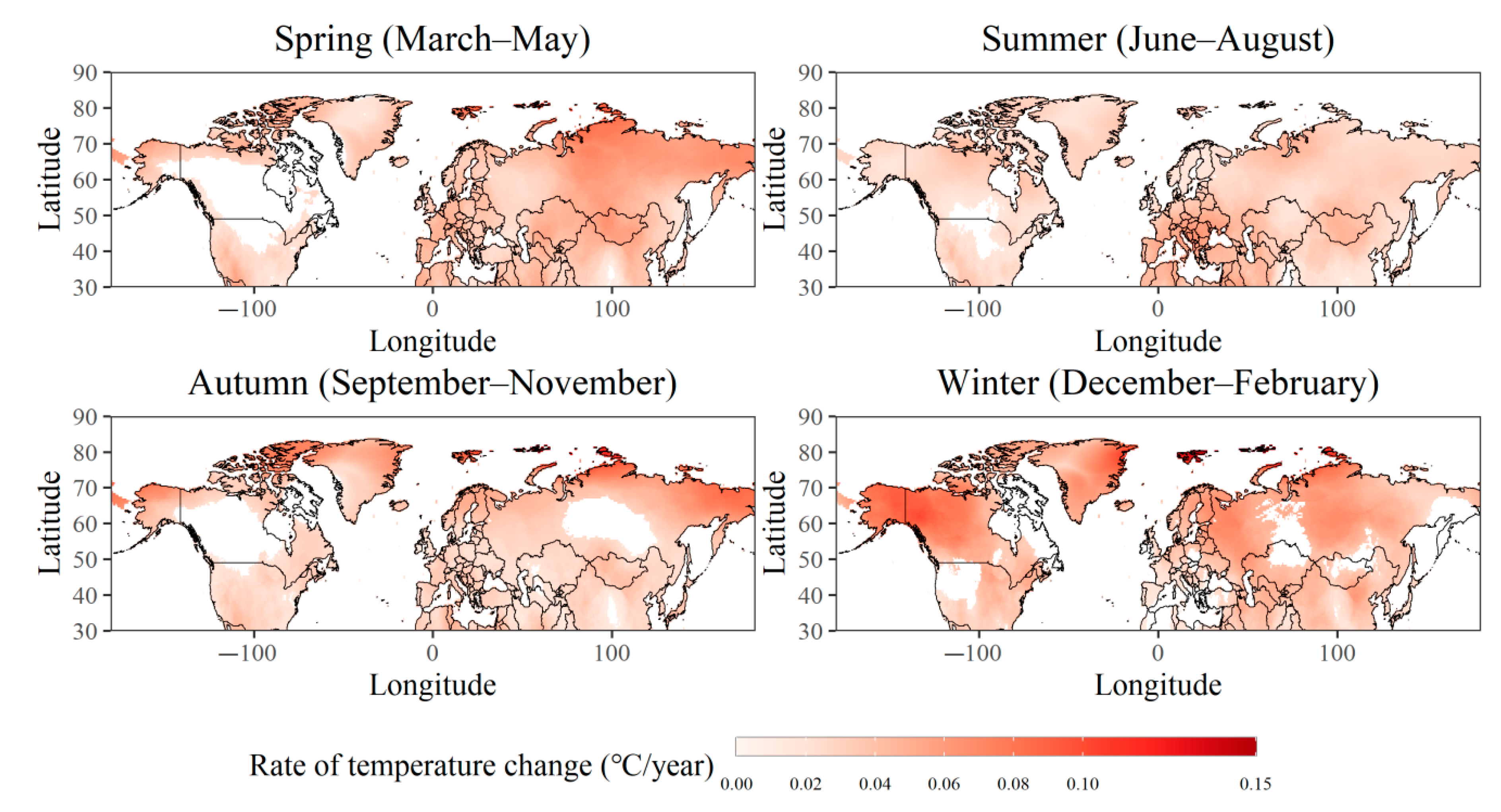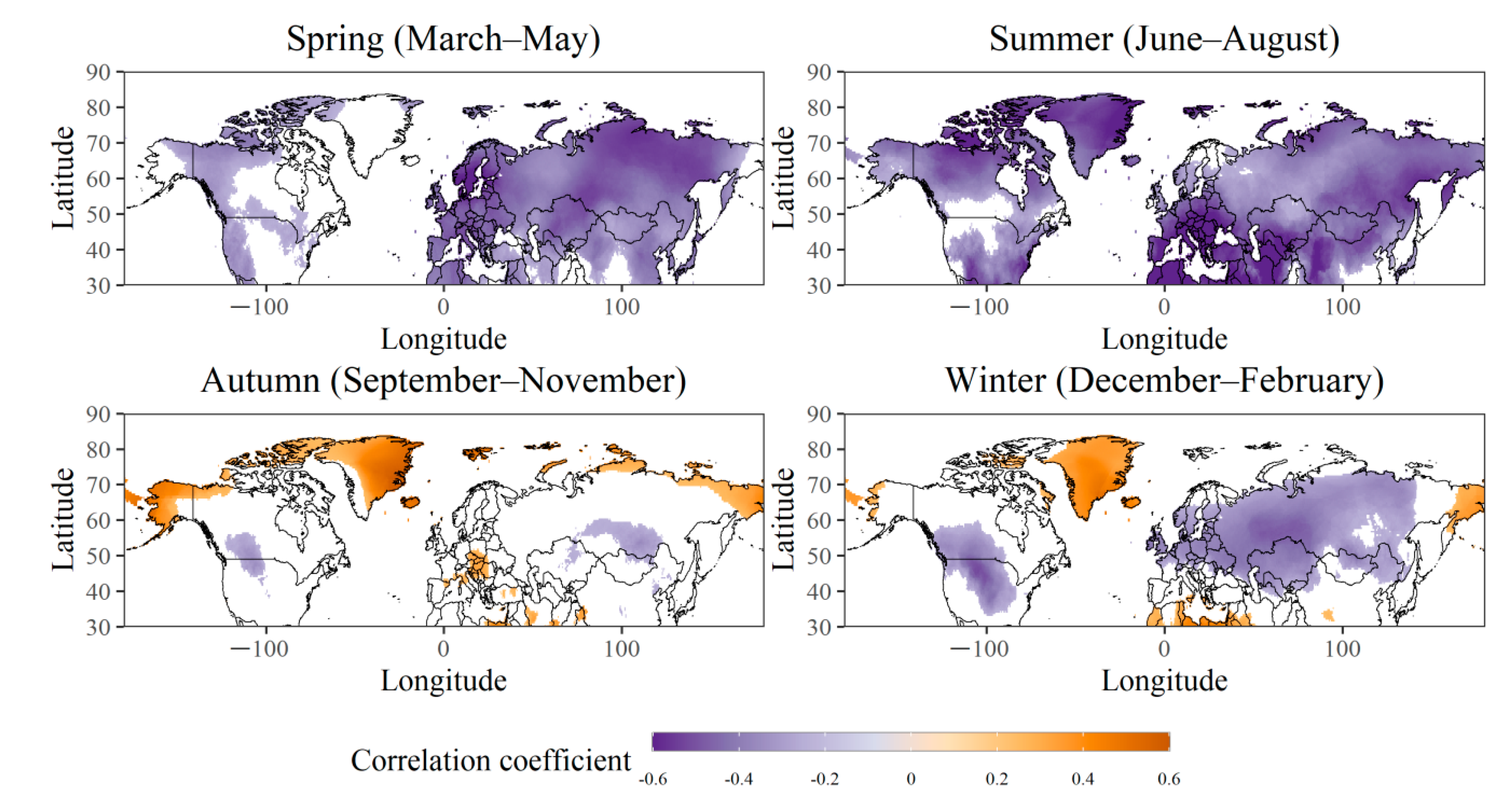Fast Warming Has Accelerated Snow Cover Loss during Spring and Summer across the Northern Hemisphere over the Past 52 Years (1967–2018)
Abstract
1. Introduction
2. Datasets and Methods
2.1. Satellite-Based Snow Cover Dataset
2.2. Temperature and Precipitation Data
2.3. Methodology and Statistics
3. Results and Discussions
3.1. Monthly Variability of Snow Cover Extent over the NH
3.2. The Accelerated Loss of SCE in Spring and Summer over the NH Landmass
3.3. The Spatiotemporal Variation of Climate over NH
3.4. Relationships between SCE, Temperature, and Precipitation across the NH, NA, and EA
4. Conclusions
Supplementary Materials
Author Contributions
Funding
Acknowledgments
Conflicts of Interest
References
- Zhong, X.; Zhang, T.; Kang, S.; Wang, K.; Zheng, L.; Hu, Y.; Wang, H. Spatiotemporal variability of snow depth across the eurasian continent from 1966 to 2012. Cryosphere 2018, 12, 227–245. [Google Scholar] [CrossRef]
- Robinson, D.A.; Dewey, K.F.; Richard, R.; Heim, J. Global snow cover monitoring: An update. Bull. Am. Meteorol. Soc. 1993, 74, 1689–1696. [Google Scholar] [CrossRef]
- Acia. Arctic Climate Impact Assessment—Scientific Report. Available online: http://amap.no/acia/ (accessed on 1 May 2005).
- Wu, X.; Che, T.; Li, X.; Wang, N.; Yang, X. Slower snowmelt in spring along with climate warming across the northern hemisphere. Geophys. Res. Lett. 2018, 45, 12331–12339. [Google Scholar] [CrossRef]
- Tomaszewska, M.; Nguyen, L.; Henebry, G. Land surface phenology in the highland pastures of montane central asia: Interactions with snow cover seasonality and terrain characteristics. Remote Sens. Environ. 2020, 240, 1–25. [Google Scholar] [CrossRef]
- Zhang, R.; Zhang, R.; Zuo, Z. Impact of eurasian spring snow decrement on east asian summer precipitation. J. Clim. 2017, 30, 3421–3437. [Google Scholar] [CrossRef]
- Cohen, J.; Entekhabi, D. The influence of snow cover on northern hemisphere climate variability. Atmos.-Ocean. 2001, 39, 35–53. [Google Scholar] [CrossRef]
- Pulliainen, J.; Aurela, M.; Laurila, T.; Aalto, T.; Takala, M.; Salminen, M.; Kulmala, M.; Barr, A.; Heimann, M.; Lindroth, A.; et al. Early snowmelt significantly enhances boreal springtime carbon uptake. Proc. Natl. Acad. Sci. USA 2017, 114, 11081–11086. [Google Scholar] [CrossRef]
- Sturm, M.; Goldstein, M.A.; Parr, C. Water and life from snow: A trillion dollar science question. Water Resour. Res. 2017, 53, 3534–3544. [Google Scholar] [CrossRef]
- Groisman, P.Y.; Karl, T.R.; Knight, R.W.; Stenchikov, G.L. Changes of snow cover, temperature, and radiative heat balance over the northern hemisphere. J. Clim. 1994, 7, 1633–1656. [Google Scholar] [CrossRef]
- Brown, R.D.; Robinson, D.A. Northern hemisphere spring snow cover variability and change over 1922–2010 including an assessment of uncertainty. Cryosphere 2011, 5, 219–229. [Google Scholar] [CrossRef]
- Dery, S.J.; Brown, R.D. Recent northern hemisphere snow cover extent trends and implications for the snow-albedo feedback. Geophys. Res. Lett. 2007, 34, L22504. [Google Scholar] [CrossRef]
- Hori, M.; Sugiura, K.; Kobayashi, K.; Aoki, T.; Tanikawa, T.; Kuchiki, K.; Niwano, M.; Enomoto, H. A 38-year (1978-2015) northern hemisphere daily snow cover extent product derived using consistent objective criteria from satellite-borne optical sensors. Remote Sens. Environ. 2017, 191, 402–418. [Google Scholar] [CrossRef]
- Bormann, K.J.; Brown, R.D.; Derksen, C.; Painter, T.H. Estimating snow-cover trends from space. Nat. Clim. Chang. 2018, 11, 923–957. [Google Scholar] [CrossRef]
- Qin, D.; Liu, S.; Li, P. Snow cover distribution, variability, and response to climate change in western china. J. Clim. 2006, 19, 1820–1833. [Google Scholar]
- Li, X.; Cheng, G.; Jin, H.; Kang, E.; Che, T.; Jin, R.; Wu, L.; Nan, Z.; Wang, J.; Shen, Y. Cryospheric change in china. Glob. Planet Chang. 2008, 62, 210–218. [Google Scholar] [CrossRef]
- Shi, X.G.; Dery, S.J.; Groisman, P.Y.; Lettenmaier, D.P. Relationships between recent pan-arctic snow cover and hydroclimate trends. J. Clim. 2013, 26, 2048–2064. [Google Scholar] [CrossRef]
- Yeo, S.R.; Kim, W.; Kim, K.-Y. Eurasian snow cover variability in relation to warming trend and arctic oscillation. Clim. Dyn. 2017, 48, 499–511. [Google Scholar] [CrossRef]
- Mccabe, G.J.; Wolock, D.M. Long-term variability in northern hemisphere snow cover and associations with warmer winters. Clim. Chang. 2010, 99, 141–153. [Google Scholar] [CrossRef]
- Armstrong, R.; Brodzik, M. Northern Hemisphere Ease-Grid 2.0 Weekly Snow Cover and Sea Ice Extent, Version 4; NASA National Snow and Ice Data Center Distributed Active Archive Center: Boulder, CO, USA, 2013.
- Robinson, D.A.; Dewey, K.F. Recent secular variations in the extent of northern-hemisphere snow cover. Geophys. Res. Lett. 1990, 17, 1557–1560. [Google Scholar] [CrossRef]
- Robinson, D.A.; Estilow, T.W. Noaa Climate Data Record (CDR) of Northern Hemisphere (NH) Snow Cover Extent (SCE), Version 1; NOAA National Centers for Environmental Information: Boulder, CO, USA, 2012.
- Helfrich, S.R.; Mcnamara, D.; Ramsay, B.H.; Baldwin, T.; Kasheta, T. Enhancements to, and forthcoming developments in the interactive multisensor snow and ice mapping system (ims) . Hydrol. Process. 2007, 21, 1576–1586. [Google Scholar]
- Ramsay, B.H. The interactive multisensor snow and ice mapping system. Hydrol. Process. 1998, 12, 1537–1546. [Google Scholar] [CrossRef]
- Washington, B.; Seymour, L.; Mote, T.; Robinson, D.; Estilow, T. Identifying and extracting a seasonal streamflow signal from remotely sensed snow cover in the columbia river basin. Remote Sens. Appl. Soc. Environ. 2019, 14, 207–223. [Google Scholar] [CrossRef]
- Ballinger, T.J.; Rohli, R.V.; Allen, M.J.; Robinson, D.A.; Estilow, T.W. Half-century perspectives on north american spring snowline and snow cover associations with the pacific-north american teleconnection pattern. Clim. Res. 2018, 74, 201–216. [Google Scholar] [CrossRef]
- Medler, M.J.; Montesano, P.; Robinson, D.A. Examining the relationship between snow cover and wildfire patterns in the western united states. Phys. Geogr. 2002, 23, 1–8. [Google Scholar] [CrossRef]
- Kim, Y.; Kimball, J.S.; Robinson, D.A.; Derksen, C. New satellite climate data records indicate strong coupling between recent frozen season changes and snow cover over high northern latitudes. Environ. Res. Lett. 2015, 10. [Google Scholar] [CrossRef]
- Lawrimore, J.; Karl, T.R.; Squires, M.; Robinson, D.A.; Kunkel, K.E. Trends and variability in severe snowstorms east of the rocky mountains. J. Hydrometeorol. 2014, 15, 1762–1777. [Google Scholar] [CrossRef][Green Version]
- Mioduszewski, J.R.; Rennermalm, A.K.; Robinson, D.A.; Wang, L. Controls on spatial and temporal variability in northern hemisphere terrestrial snow melt timing, 1979–2012. J. Clim. 2015, 28, 2136–2153. [Google Scholar] [CrossRef]
- Harris, I.; Jones, P.D.; Osborn, T.J.; Lister, D.H. Updated high-resolution grids of monthly climatic observations—The cru ts3.10 dataset. Int. J. Climatol. 2014, 34, 623–642. [Google Scholar] [CrossRef]
- Devlin, C.S.J. Locally weighted regression: An approach to regression analysis by local fitting. J. Am. Stat. Assoc. 1988, 83, 596–610. [Google Scholar]
- Estilow, T.; Young, A.; Robinson, D. A long-term northern hemisphere snow cover extent data record for climate studies and monitoring. Earth Syst. Sci. Data Discuss. 2015, 7, 134–142. [Google Scholar] [CrossRef]
- Kitaev, L.M.; Kislov, A.; Krenke, A.; Razuvaev, V.; Martuganov, R.; Konstantinov, I. The snow cover characteristics of northern eurasia and their relationship to climatic parameters. Boreal Environ. Res. 2002, 7, 437–445. [Google Scholar]
- Kitaev, L.; Forland, E.; Razuvaev, V.; Tveito, O.E.; Krueger, O. Distribution of snow cover over northern eurasia. Nordic Hydrol. 2005, 36, 311–319. [Google Scholar] [CrossRef]
- Brock, B.W.; Willis, I.C.; Sharp, M.J. Measurement and parameterization of albedo variations at haut glacier d’arolla, switzerland. J. Glaciol. 2000, 46, 675–688. [Google Scholar] [CrossRef]
- Wu, X.; Wang, N.; Lu, A.; Pu, J.; Guo, Z.; Zhang, H. Variations in albedo on dongkemadi glacier in tanggula range on the tibetan plateau during 2002-2012 and its linkage with mass balance. Arct. Antarct. Alp. Res. 2015, 47, 281–292. [Google Scholar] [CrossRef]
- Brown, R.D. Northern hemisphere snow cover variability and change, 1915–1997. J. Clim. 2000, 13, 2339–2355. [Google Scholar] [CrossRef]
- Rasmussen, R.; Liu, C.; Ikeda, K.; Gochis, D.; Yates, D.; Chen, F.; Tewari, M.; Barlage, M.; Dudhia, J.; Yu, W.; et al. High-resolution coupled climate runoff simulations of seasonal snowfall over colorado: A process study of current and warmer climate. J. Clim. 2011, 24, 3015–3048. [Google Scholar] [CrossRef]
- Brown, R.; Schuler, D.V.; Bulygina, O.; Derksen, C.; Luojus, K.; Mudryk, L.; Wang, L.; Yang, D. Arctic Terrestrial Snow Cover; Snow, Water, Ice and Permafrost in the Arctic (SWIPA), Arctic Monitoring and Assessment Programme (AMAP): Oslo, Norway, 2017; pp. 25–64. [Google Scholar]
- Rangwala, I.; Sinsky, E.; Miller, J.R. Amplified warming projections for high altitude regions of the northern hemisphere mid-latitudes from cmip5 models. Environ. Res. Lett. 2013, 8. [Google Scholar] [CrossRef]
- Flanner, M.; Shell, K.; Barlage, M.; Perovich, D.; Tschudi, M. Radiative forcing and albedo feedback from the northern hemisphere cryosphere between 1979 and 2008. Nat. Geosci. 2011, 4, 151–155. [Google Scholar] [CrossRef]
- Yu, L.; Liu, T.; Zhang, S. Temporal and spatial changes in snow cover and the corresponding radiative forcing analysis in siberia from the 1970s to the 2010s. Adv. Meteorol. 2017, 2017, 1–11. [Google Scholar] [CrossRef]
- Abdul Aziz, O.I.; Burn, D.H. Trends and variability in the hydrological regime of the mackenzie river basin. J. Hydrol. 2006, 319, 282–294. [Google Scholar] [CrossRef]
- Tan, A.; Adam, J.C.; Lettenmaier, D.P. Change in spring snowmelt timing in eurasian arctic rivers. J. Geophys. Res. Atmos. 2011, 116, D03101. [Google Scholar] [CrossRef]
- Stewart, I.T.; Cayan, D.R.; Dettinger, M.D. Changes toward earlier streamflow timing across western north america. J. Clim. 2005, 18, 1136–1155. [Google Scholar] [CrossRef]
- Zhang, W.; Kang, S.; Shen, Y.; He, J.; Chen, A. Response of snow hydrological processes to a changing climate during 1961 to 2016 in the headwater of irtysh river basin, chinese altai mountains. J. Mt. Sci.-Engl. 2017, 14, 2295–2310. [Google Scholar] [CrossRef]
- Clark, M.P.; Serreze, M.C.; Robinson, D.A. Atmospheric controls on eurasian snow extent. Int. J. Climatol. 1999, 19, 27–40. [Google Scholar] [CrossRef]
- Yu, B.; Lin, H. Modification of the wintertime pacific–north american pattern related north american climate anomalies by the asian–bering–north american teleconnection. Clim. Dyn. 2019, 53, 313–328. [Google Scholar] [CrossRef]
- Räisänen, J. Warmer climate: Less or more snow? Clim. Dyn. 2008, 30, 307–319. [Google Scholar] [CrossRef]







| Season | NH | EA | NA | |||
|---|---|---|---|---|---|---|
| tem | pre | tem | pre | tem | pre | |
| Spring | −0.654 ** | −0.104 | −0.688 ** | −0.083 | −0.178 | 0.071 |
| Summer | −0.729 ** | −0.365 ** | −0.744 ** | −0.215 | −0.343 * | −0.127 |
| Autumn | 0.052 | 0.318 * | −0.111 | 0.217 | −0.424 ** | −0.03 |
| Winter | −0.212 | 0.077 | −0.277 * | −0.089 | 0.081 | 0.003 |
© 2020 by the authors. Licensee MDPI, Basel, Switzerland. This article is an open access article distributed under the terms and conditions of the Creative Commons Attribution (CC BY) license (http://creativecommons.org/licenses/by/4.0/).
Share and Cite
Wu, X.; Shen, Y.; Zhang, W.; Long, Y. Fast Warming Has Accelerated Snow Cover Loss during Spring and Summer across the Northern Hemisphere over the Past 52 Years (1967–2018). Atmosphere 2020, 11, 728. https://doi.org/10.3390/atmos11070728
Wu X, Shen Y, Zhang W, Long Y. Fast Warming Has Accelerated Snow Cover Loss during Spring and Summer across the Northern Hemisphere over the Past 52 Years (1967–2018). Atmosphere. 2020; 11(7):728. https://doi.org/10.3390/atmos11070728
Chicago/Turabian StyleWu, Xuejiao, Yongping Shen, Wei Zhang, and Yinping Long. 2020. "Fast Warming Has Accelerated Snow Cover Loss during Spring and Summer across the Northern Hemisphere over the Past 52 Years (1967–2018)" Atmosphere 11, no. 7: 728. https://doi.org/10.3390/atmos11070728
APA StyleWu, X., Shen, Y., Zhang, W., & Long, Y. (2020). Fast Warming Has Accelerated Snow Cover Loss during Spring and Summer across the Northern Hemisphere over the Past 52 Years (1967–2018). Atmosphere, 11(7), 728. https://doi.org/10.3390/atmos11070728





